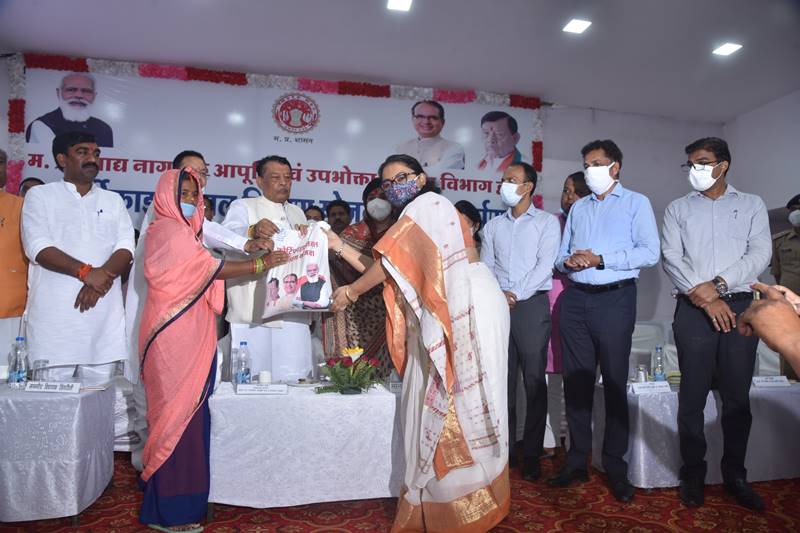The Madhya Pradesh government will soon provide fortified rice to beneficiaries of the public distribution system (PDS). This, claims the state government, will help address anaemia and nutritional deficiencies in the state.
Rice fortification is the process of adding micronutrients such as iron, folic acid, Vitamin B12, to regular rice. The pilot project has recently been launched in the Singrauli district.
“Rice is an ideal vehicle for fortification. The inclusion of fortified rice in the public distribution system will offer a sustainable and cost-effective method for improving the nutritional status of the population in the state,” Tarun Pithore, Managing Director, Madhya Pradesh State Civil Supplies Corporation, said during the launch of the pilot project on September 23.
The pilot project was launched by Food and Civil Supplies Consumer Protection Minister Bisahulal Singh.
As per the statement issued by the Department of Food, Civil Supplies and Consumer Protection Madhya Pradesh, the fortified rice will be provided at a rate of Re 1 per kg to the PDS beneficiaries as part of the pilot project.
This decision of the Madhya Pradesh government is in line with the recent announcement of Prime Minister Narendra Modi, who declared that underprivileged beneficiaries under various government schemes will be provided fortified rice from 2024 to address malnutrition.
“We will give rice fortified with nutrition to the poor. Be it the rice available at the ration shop, the rice provided to the children in the mid-day meal, or the rice available through every scheme, it shall be fortified by the year 2024,” he said during his Independence Day speech on August 15.
Be it rice available at ration shop, rice available in mid-day meal, rice available through every scheme will be fortified by the year 2024: PM @narendramodi#IndiaIndependenceDay #AmritMahotsav pic.twitter.com/6IqyaFj12c
— PB-SHABD (@PBSHABD) August 15, 2021
Also Read: Stop compulsory food fortification: Health activists write to FSSAI
Addressing malnutrition through fortified rice?
The National Family Health Survey 2015-16 shows that in Madhya Pradesh, 68.9 per cent of children aged 6-59 months, 52.5 per cent women of reproductive age, 54.6 per cent pregnant women, and 21.2 per cent adolescents (10-19 years) suffer from anaemia. The data indicates iron-deficiency anaemia continues to be a cause of concern for Madhya Pradesh.
“Among the various fortification modalities available, what makes rice an excellent food staple for delivering micronutrients is its reach — 65 per cent of Indians consume rice,” stated the state government statement dated September 23.
Also Read: ‘Rice and wheat in India are lot less nutritious than they were 50 years ago’
According to the National Sample Survey Office, NSSO 2015, per capita rice consumption in India is 6.8 kilograms per month.
“One of the most effective, scalable, affordable, and sustainable ways to address micronutrient deficiencies among vulnerable populations is through the distribution of fortified staples via the social safety net programmes,” Mansi Shekhar, State Program Representative, Nutrition International Madhya Pradesh, was quoted as saying.
Nutrition International, a global nutrition organisation working with the government of Madhya Pradesh is extending its technical expertise to ensure the successful implementation of this programme.
Public health experts unhappy
The government claims that food fortification as a complementary strategy will additionally contribute to addressing the anaemia burden in the state.
But the decision of providing fortified rice has appalled several health and nutrition experts across the country. They assert that unnecessary food fortification would bring socio-economic impacts such as market shifts in favour of large corporations, loss of livelihoods for small and informal players, monocultures in diets and reliance on packaged foods.
They also pointed out that the actual solution is to improve diets and food diversity such as inclusion of nutritious vegetables, millets, animal protein, and dairy products.
“To maintain a diverse diet is hugely important to health and to nutrition. It cannot be replaced by providing fortified foods. If you need iron, you also need protein and other micronutrients. Good quality diverse food provides that,” said Vandana Prasad, Noida-based public health expert and paediatrician.
“The government is stressing on providing fortified rice. It is suggesting to keep dumping one nutrient after another. Is that how haemoglobin goes up? This is a complete travesty of social justice and rights to food and nutrition,” she added. Prasad suggested inclusion of millets and eggs in the diet of beneficiaries.
Recently, Odisha government has decided to include pulses, millets, oilseeds, fruits and vegetables in its government welfare programmes, including meals offered at anganwadis and midday meals at schools.













